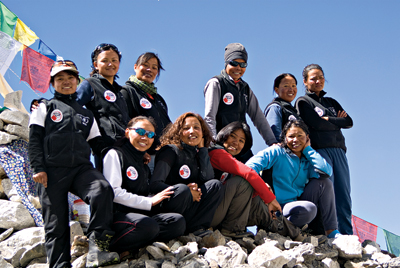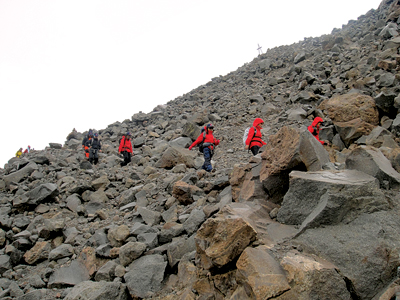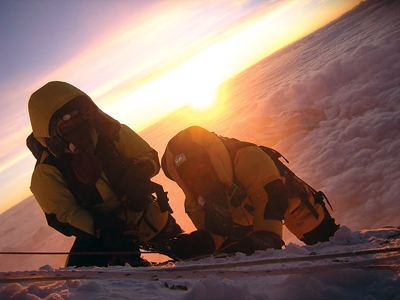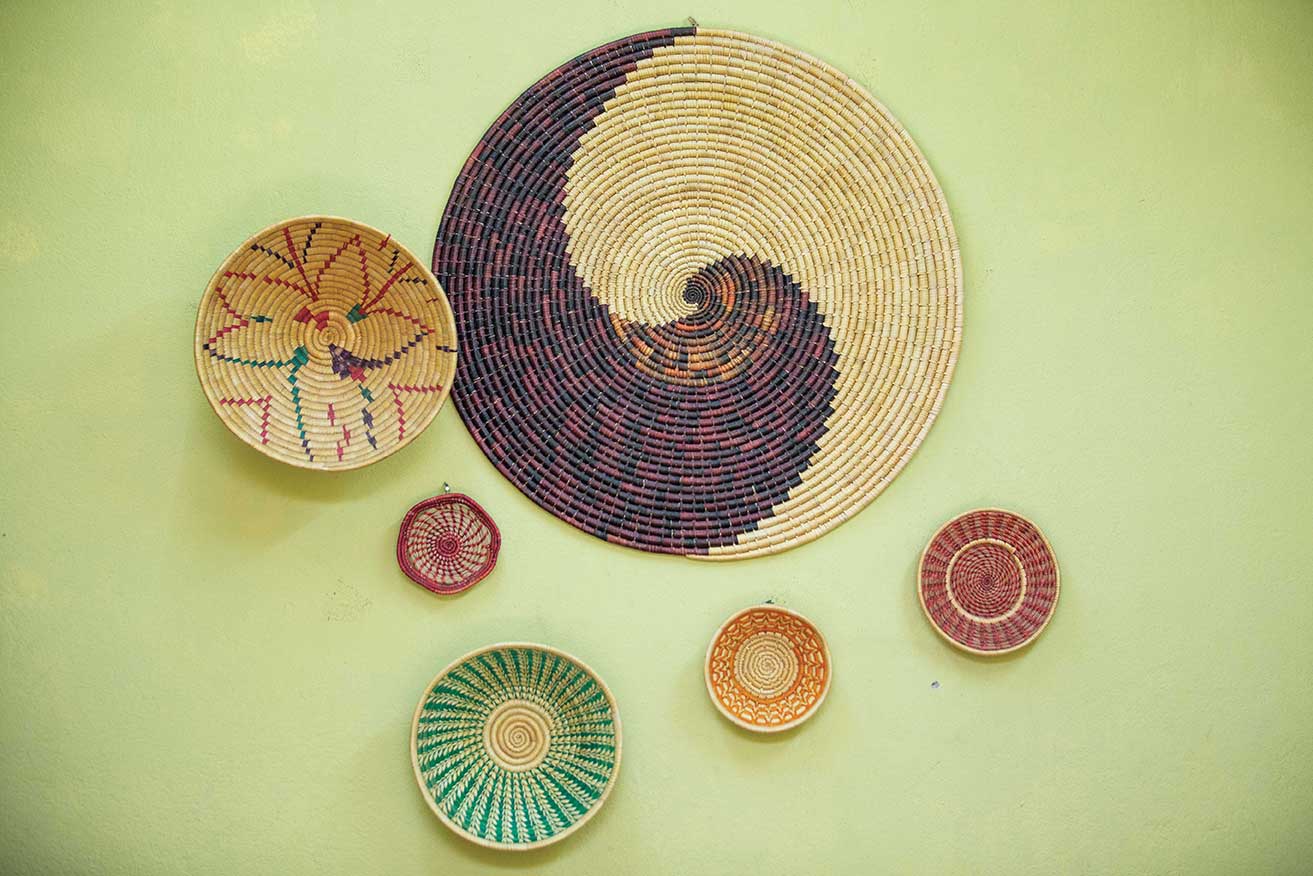While sipping cappuccinos with seven Nepali girls, what would you choose to talk about? Perhaps bargain hunting, the latest trends or Bollywood hits? It’s unlikely you would find yourself discussing climbing Mt Everest, but then these seven girls are extraordinary.
 Their story began in 2007, when Climbers Club, a local non-governmental organisation put together a team of determined young ladies to climb Mt Everest. Their aims were to highlight women’s access and participation in mountaineering and ecological problems throughout the Himalaya. Thousands of girls applied from all over Nepal. Only nine were selected and the whole team went on to reach the summit in May 2008. To climb a mountain like Everest takes enormous effort, but for young women to be successful mountaineers, an industry that is typically dominated by men, means you have to fight even harder.
Their story began in 2007, when Climbers Club, a local non-governmental organisation put together a team of determined young ladies to climb Mt Everest. Their aims were to highlight women’s access and participation in mountaineering and ecological problems throughout the Himalaya. Thousands of girls applied from all over Nepal. Only nine were selected and the whole team went on to reach the summit in May 2008. To climb a mountain like Everest takes enormous effort, but for young women to be successful mountaineers, an industry that is typically dominated by men, means you have to fight even harder.
The team’s success seems extraordinary considering their diverse backgrounds and it is obvious that their combined experience was far more profound and long lasting than any of them had expected. Since Everest, two of the team have moved on to new projects, however, the reaming seven have set an even harder goal – to climb the highest peak on each continent.
Rather than individual brilliance the seven girls lay the source of their success on teamwork based on shared values, a paradigm that they believe is highly relevant for women in Nepal and around the world. Browsing through photos of their early lives you begin to realise how their journey has changed each of theirworlds. Pictures of childhood memories, village scenes, family festivals and get togethers, the occasional picture of a memorable trip and teenage glamour shots are a world away from mountaineering at 8,848 metres (29,028 feet). From the variety of outfits and landscapes in the photos, it is obvious that they are drawn from six of Nepal’s ethnic groups, Brahmin, Chettri, Danwar, Gurung, Newar and Sherpa communities.
 Questions about how they managed to integrate their diverse backgrounds are waved away as being irrelevant. Theirshared dream was far more important than ethnicity. But each has an intensely personal story of how joining the team and climbing together has changed their lives.
Questions about how they managed to integrate their diverse backgrounds are waved away as being irrelevant. Theirshared dream was far more important than ethnicity. But each has an intensely personal story of how joining the team and climbing together has changed their lives.
Only Pema and Nimdoma (who was 17 when she summited – the youngest female on record according to the Himalayan Database until 2012 had any family connection with trekking and mountaineering. They had grown up in traditional Sherpa villages and had some idea about the issues facing a climbing expedition. The other members of the team had various outdoor backgrounds but knew little of what would be involved. An intensive one-year training and fitness program gave each of them the skills and strength to climb, but all confess that it was thanks to help from each other that they were successful (they summited over three days from the 22nd to 25th May 2008). They quickly realised each had strengths and weaknesses that meant alone they would fail and success would only come if they formed a very strong team bond.That bond remains long after the mountain was conquered.
Each of the team tries to balance ‘real-world’ jobs or studies with traditional family lives and the interests of the team. They continually support each other and the team has become a way to indulge their mutual passion for adventure and challenging themselves in a way that falls outside day-to-day lives. None of their families can fully understand what they have been through so although they each receive support from home, the team is far more than friendship; it’s a sisterhood that will last a lifetime.
 As well as being a source of finding new challenges in the outdoors the girls use the team to pursue new goals, both together and as individuals. They plan to open a trekking company with a social entrepreneurship focus, where a key goal is to empower women (especially those in rural and/or disadvantaged environments) by providing them with employment. Theybelieve that the status of women can be improved by providing opportunities to develop financial independence and thus autonomy, something they have all learned over the last four years.
As well as being a source of finding new challenges in the outdoors the girls use the team to pursue new goals, both together and as individuals. They plan to open a trekking company with a social entrepreneurship focus, where a key goal is to empower women (especially those in rural and/or disadvantaged environments) by providing them with employment. Theybelieve that the status of women can be improved by providing opportunities to develop financial independence and thus autonomy, something they have all learned over the last four years.
The desire to help raise awareness of women’s issues, including education, is very strong in the team, especially for Maya. As a child, her father arranged a marriage for her on her fourteenth birthday. She ran away from hom the day before, thus gaining freedom but losing her family forever.
Maya managed to escape from a life she neither asked for nor wanted but other girlsmight not get the same opportunity. She is obviously uncomfortable telling her story but feels it is important to highlight an issue that affects lives across Nepal. As she remembers traumatic times the other team members fall silent and you can sense how important Maya’s message is for them. Increasing empowerment means choices, not only for the girls but for the entire family and broader community. Choices, Maya believes, she and other girls have a right to.
 It is easy to see that the time they have together is important to each of them, but surely boyfriends, husbands and their future family lives will take priority? The recent marriage of Shailee, was a ‘team event’ and the first of what they all hope will be a future that includes their husbands and children. However, there is passion in all of their eyes when they talk of protecting ‘team-time’. Almost in unison they exclaim, ‘any husband or boyfriend will just have to understand that sometimes the team comes first!’
It is easy to see that the time they have together is important to each of them, but surely boyfriends, husbands and their future family lives will take priority? The recent marriage of Shailee, was a ‘team event’ and the first of what they all hope will be a future that includes their husbands and children. However, there is passion in all of their eyes when they talk of protecting ‘team-time’. Almost in unison they exclaim, ‘any husband or boyfriend will just have to understand that sometimes the team comes first!’
Determination to not live within boundaries set by others means the team tries to be self-reliant, so each member has a general role when away from the mountains. The vitality and enthusiasm of Pujan means the team consider her to be the team ‘president’ as well as handling administration. A journalist by profession, Shailee is the spokesperson and hopes to develop a script-writing career. Both from impoverished backgrounds in the Kathmandu valley, Chunu’s affection and caring nature earns her the title ‘group mother’, while Pema is always the first to volunteer to help out whenever help is required. Maya brings self-confidence and motivation and Nimdoma and Asha make sure everyone’s climbing skills and fitness levels are maintained.
At a recent workshop organised by supporters the team focused on their mission to climb the seven summits and highlightfemale empowerment issues. They want to send a positive message to the world and have developed a mission statement, “Together We Reach Higher!”
When they talk of the mountains their enthusiasm is infectious. These girls love the hills and overcoming challenges together; next on the list is the ‘seven summits’, the highest place on each continent, which includes Mt Everest (Asia), Kilimanjaro (Africa), Elbrus (Europe), Mt Kosciuszko (Australia), Vinson (Antarctica), Mt McKinley (North America), Aconcagua (South America). So far they have scaled three of the seven, Mt Everest, Kosciuszko and Elbrus. The three expeditions were all very different.
Everest was a huge event both for the team and for women’s mountaineering in Nepal. Few expeditions get every member to the summit of the world’s highest peak and their success surprised many. They certainly delighted their many supporters, including, Pemba Dorje Sherpa, who holds the Everest speed climbing record (8 hours and 10 minutes), Non Resident Nepalis, the Nepal Mountaineering Association (NMA), the United Nations World Food Program, the Nepal Government and The North Face.
In July 2010, the team travelled to Australia to both climb the highest peak on the continent, Mt Kosciuszko (2228m – 7310ft) and to spend some time fundraising. The trip to Australia went well with a successful climb and support from the NMA, Nepal Airlines, Crossing Land Education Trust, Veg Climate Alliance, Outdoor Education Group. However, despite summiting Elbrus, 5642m – 18510ft, (supported by the NMA), the team came home to discover that some sponsors hadn’t fulfilled their promises and all of the team had to borrow money to cover costs. Rather than taking on any more expeditions in 2011 they decided to knuckle down and clear their debts to begin afresh this year. For some of the team this has proved to one of the greatest challenges of all.
They are now ready to attempt Kilimanjaro, but they need help! The team have been working hard to raise sponsorship both in Nepal and internationally but with the economic climate being as it is, fundraising is difficult. Expecting that climbing ‘Kili’ will appeal to a broad audience the girls have decided to invite supporters to join them. For US$3,500, those interested will get a chance to summit the highest point in Africa and enjoy a three-day safari, and everyone is welcome!
Getting to meet the team is an insight into a world few of us can imagine, into a team dynamic based on belief and shared values that are strong enough to conquersome of the world’s greatest challenges.Together and individually they are inspiring, humbling and a delight to be with. Each Saturday in Kathmandu the team gets together and goes for a group walk. The idea is to share their own experiences as well as learn from the advice of an invited expert. The range of topics covered in the walks is surprising, from botany to fitness, from climbing to healthcare and the girls are all happy to share their stories about life both on and off the mountain. They believe it is core to their mission to raise awareness about what women can achieve and how important self-belief is to success; messages we all need to hear!











